Aviation against tanks (part of 7)
The YakB-12,7 large-caliber four-barreled machine gun mounted on the Mi-24В was well suited to combat manpower and unarmored equipment. There is a case when in Afghanistan a bus with insurgents was literally cut in two by a thick line of YakB-12,7. But the helicopter crews, and especially the gunsmiths of the YakB-12,7, did not enjoy particular popularity. During the fighting revealed serious shortcomings of the machine gun. The complexity of the design and high thermal and vibration loads led to frequent failures due to pollution and overheating. Also revealed problems with feeding the cartridge belt. With a queue length of about 250 shots, the machine gun began to "spit" and go crazy. On average, one failure occurred for every 500 shots, and this is with the rate of fire of 4000 — 4500 shots / min.
This is not to say that no measures were taken to increase the reliability of the built-in machine gun installation. So, YakBYu-12,7 was presented for testing with improved reliability and rate of fire, increased to 5000 rounds / min. But at the same time, the weight of the upgraded machine gun reached 60 kg, which was 15 kg heavier than the YakB-12,7. By that time, the military was largely disappointed with machine guns mounted on a fire support helicopter. The effective range of 12,7 mm machine guns left much to be desired, in addition, the army command aviation wanted to have built-in weapons with which it was possible to hit armored vehicles and field-type fortifications. In this regard, in 1981, the production of the “artillery” modification of the Mi-24P began. In just 10 years of mass production, 620 cars were built.
According to its flight characteristics, the composition of the avionics and outboard armament, the helicopter is generally similar to the Mi-24В, and was distinguished by the presence of fixed 30-mm gun GSH-2-30 (GSH-30K) mounted on the starboard. The HSH-30K with trunks extended to 2400 mm is equipped with an evaporative cooling system and has a variable firing rate (300-2600 rds / min). The gun barrels are lengthened by 900 mm not only to improve the ballistic characteristics, but also for layout reasons - to divert the muzzle gases forward, away from the side of the car. For the same reason, the helicopter GSH-30K trunks were equipped with flame arresters, reducing the impact of the impact load on the Mi-24P board.
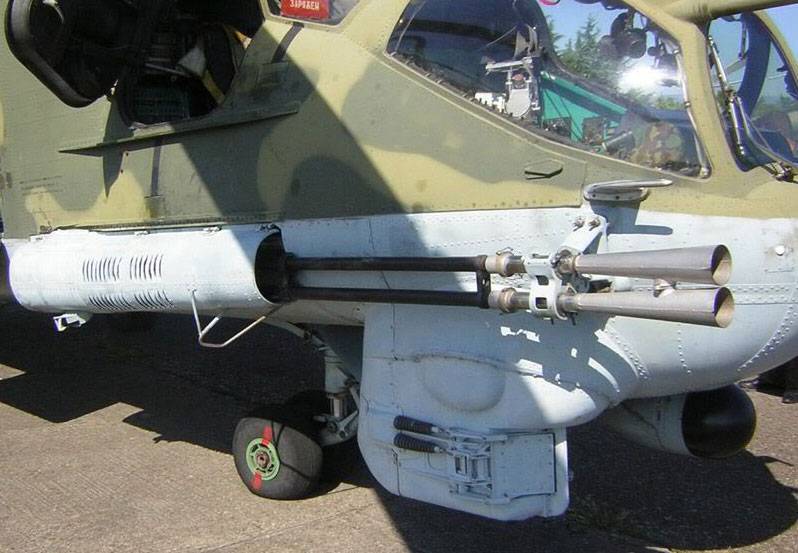
BR-30 armor-piercing-explosive projectile with an initial projectile speed of 940 m / s, at a distance of up to 1000 m easily affects APCs and IFVs. With a certain amount of luck from GSh-30K, you can break through the upper relatively thin armor tank, "Gnaw" a long line of board or stern. However, the 30-mm air gun was too powerful and heavy for installation on a combat helicopter. The crushing return adversely affected the reliability of avionics, and worthy goals for such a powerful weapon were not always found. When operating against an enemy with strong ground air defense, ATGMs and powerful S-8 and S-13 anti-aircraft guns are much preferable, since during helicopter shooting at ground targets the helicopter is more vulnerable to anti-aircraft fire.
Too powerful and heavy GSH-30K also secured motionless, and only the pilot who controlled the helicopter and carried out the dropping of bombs and the launch of the NAR could fire from it. Thus, the navigator-operator, in whose possession was the ATGM guidance station, was often left without work in local conflicts of low intensity and various “anti-terrorist” operations.
For a relatively low-speed helicopter a very valuable quality was the possibility of using mobile rifle guns and firing at a target regardless of the direction of flight. Estimates of the various variants of built-in weapons showed that a mobile unit with an 23-mm gun would be much more effective.
The helicopter with the new gun mount received the designation Mi-24VP. Compared with the YakB-12,7, the new cannon turret MOTS-24 with a double-barreled GSH-23L with a constant horizontal shelling sector in the vertical plane made it possible to deflect the gun from + 10 ° to -40 °.
One more innovation introduced on this modification of the twenty-four was the Ataka-V ATGM system based on the Sturm-B. The difference from Sturm was the use of a new sight and sight system with a laser rangefinder and an optical television channel. During the use of the anti-tank missile system, the helicopter can maneuver with a yaw angle of up to 110 ° and a roll of up to 30 °.
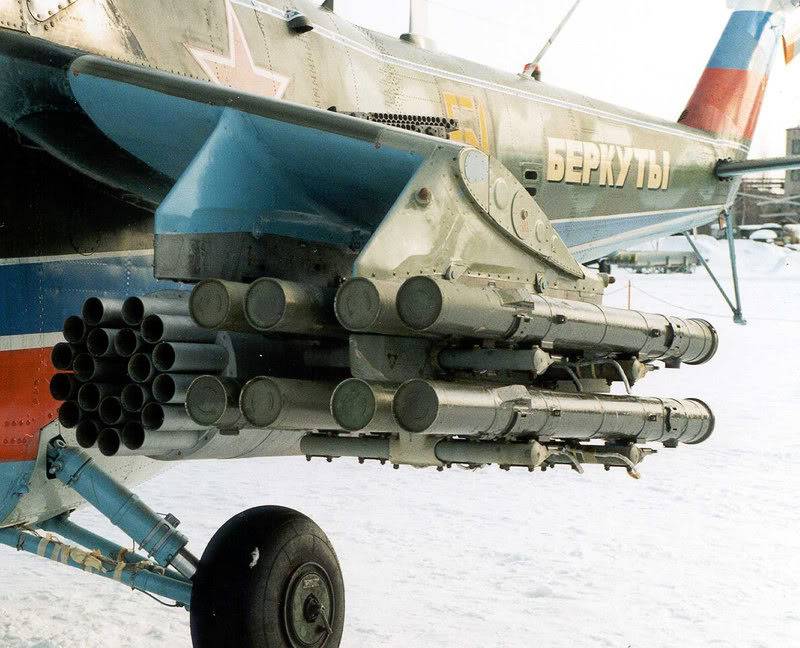
The new 9М120 ATGM with a tandem cumulative warhead, based on the 9М114 rocket of the Sturm-B complex, thanks to the use of a more powerful engine, has increased the range to 6000 m, as well as more powerful 800 mm armor for dynamic protection In addition to missiles with a tandem cumulative warhead, variants with a warhead of cumulative fragmentation and high-explosive fragmentation types have been developed. The highest effectiveness of the use of ATGM "Ataka-B" is achieved at a distance of up to 4000. At the same time it is possible to launch rockets at zero altitude, which reduces the helicopter's vulnerability to air defense systems. The probability of hitting a tank with a single missile in a combat situation at a distance of up to 4000 is 0,65-0,9. Later for use in the Ataka-VM ATGM system, an 9М120М ATGM was developed with a launch range of up to 8000 m and an armor penetration 950 mm. The upgraded Mi-24BH, which was a further development of the Mi-24VP, was equipped with a Top torch sighting system with a laser rangefinder and optical, television and thermal imaging channels. The Thor system, in addition to searching and tracking targets, is also used for the guidance of an ATGM.
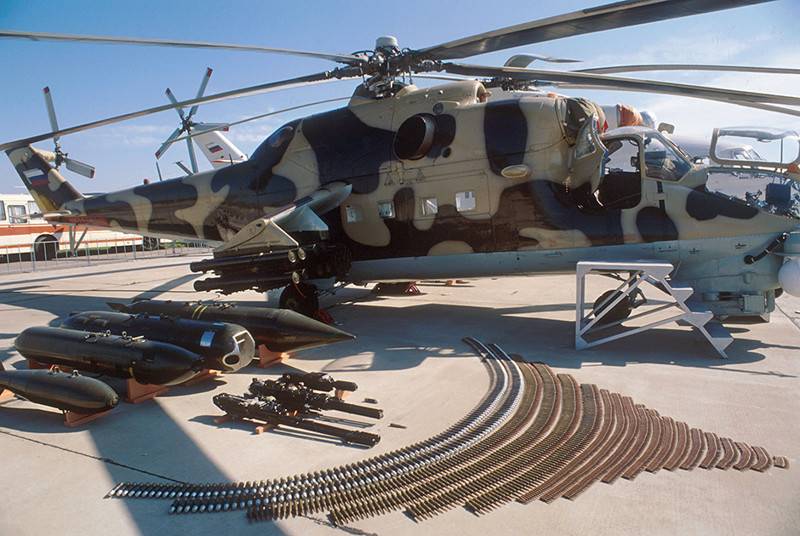
Mi-24VP became the most perfect combat helicopter launched into a series in the Soviet Union. Production of the Mi-24VP began in the 1989 year, and lasted until the 1992 year. Due to the reduction in military spending and the collapse of the USSR, helicopters of this modification have built relatively little. Through a deep modernization of the Mi-24VP in 1995, the Mi-24ВМ (Mi-35М) was created. The serial construction of the helicopter was established at the Rosvertol enterprise in Rostov-on-Don.
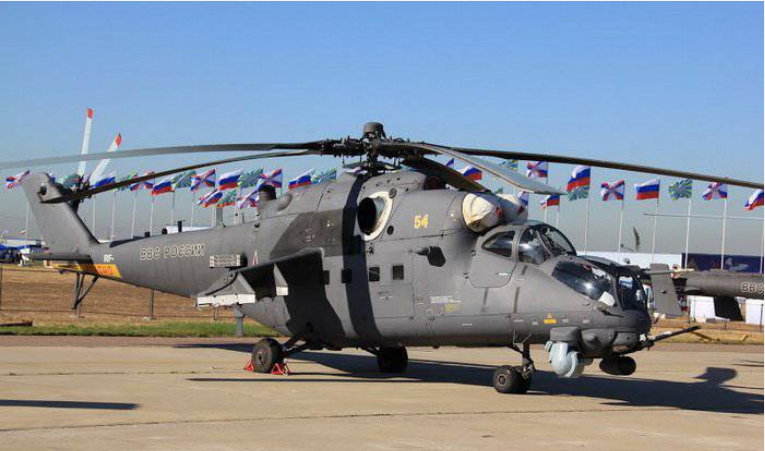
Initially, the Mi-35M was created exclusively with an export scope. But the challenges that our country faced in the 21 century, and the “natural decline” of earlier modifications of the “twenty-fours”, required equipping helicopter units with new strike machines. According to data published in open sources, starting from 2010, the Russian Defense Ministry has ordered 49 Mi-35М.
The most notable difference in the Mi-35M from the Mi-24 family of helicopters was the non-retractable landing gear, which simplified the design and reduced take-off weight. At the same time, due to the use of more powerful VK-2500-02 engines with increased altitude and increased resource, the maximum speed, due to the increase in drag, did not decrease much and amounted to 300 km / h. Another notable feature was the use of shortened wings with girder holders DBL-UH, which allow the installation of multi-seat APU-8 / 4-U launchers used to deploy guided missiles on the helicopter. In addition to the strike weapons, missiles were introduced into the arsenal of the helicopter to fight against air targets: Igla, Р-60М and Р-73. The shortened wing with new holders made it possible to speed up the equipment of the Mi-35M with various types of aircraft armament with the help of a lifting mechanism.
To improve the performance of the Mi-35M and maneuver at speeds close to zero, a new carrier system is used. Among the innovations introduced are the carrying screw of increased survivability, the blades of which are made of composite materials. Blades of the screw have smaller weight and the increased technical resource. They retain their performance even with 30-mm projectiles. Together with the rotor, a new titanium alloy bush with elastomer hinges, which do not require lubrication, is used. The four-blade tail rotor with a two-tier X-shaped blade arrangement and a torsion bar suspension is also made from composite materials.
Improvements made to the avionics are not so striking, but are no less important for increasing the combat potential. The helicopter is equipped with a modernized sight-and-aiming system OPS-24Н compatible with night-vision equipment. The Mi-35M helicopter has a thermal imaging and target tracking system, as well as night vision devices. This enables the crew to detect and recognize a target at a distance of several kilometers at any time of the day. The satellite navigation system associated with the helicopter's onboard computer with high accuracy determines the coordinates of the helicopter during the execution of the task and significantly reduces the time it takes to route. All this enables effective all-day combat use of the helicopter and can significantly reduce the load on the crew.
At the moment, the Mi-35M is the pinnacle of the evolutionary development of the Mi-24 family. In a number of countries, efforts are being made to modernize Soviet-made combat helicopters.
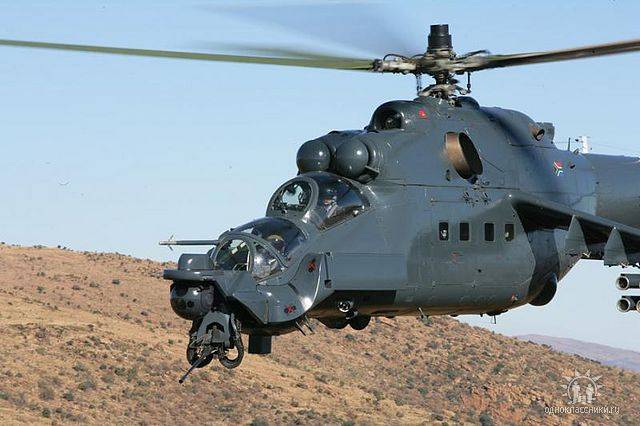
The most famous options for upgrading offered by the South African company Advanced Technologies and Engineering (ATE). The main changes in the process of improving the combat performance of the Mi-24 are made in the front of the helicopter. The cockpit and bow section has a new configuration and modern avionics. The cabin layout provides a better overview than on the Mi-24D / B. According to statements made by representatives of ATE, the helicopter’s maneuverability is enhanced, which in turn makes it easier to fly at extremely low altitudes. Thanks to the use of Kevlar armor, the helicopter's mass is reduced by 1,5 tons.
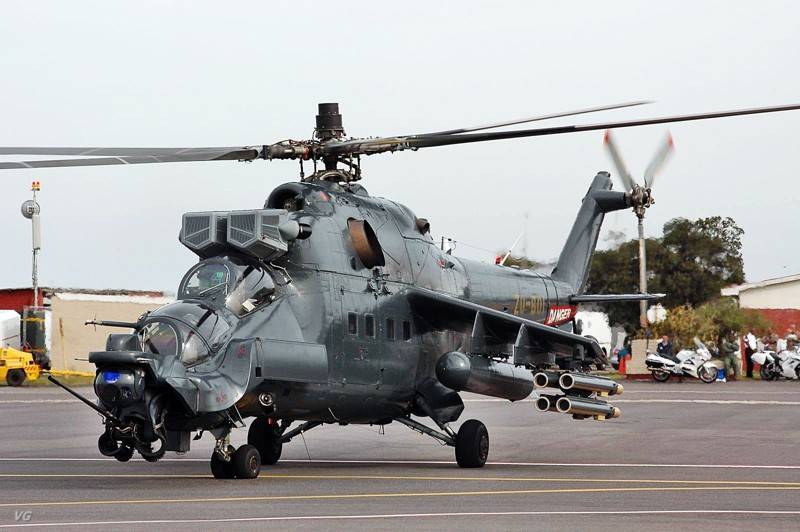
The crew cabins are equipped with color multifunctional displays, satellite navigation system, night vision equipment and Argos-410 compact gyro-stabilized sight. The weapons control equipment of the Mi-24В modernized in South Africa consists of the FLIR multichannel aiming complex with automatic target tracking and an integrated laser range finder, a helmet-assisted aiming system and an information display system. The composition of the avionics can vary considerably. Currently known 4 modification of the helicopter, denoted as Mi-24 Super Hind. The first modification of the Super Hind Mk II, commissioned by Algeria, appeared in the 1999 year. Currently, the Super Hind Mk II, Mk III and Mk IV helicopters are deployed in the armed forces of Algeria, Azerbaijan and Nigeria. Re-equipment, modernization and refurbishment of the Mi-24В in the past were carried out jointly by Rostvertol, the South African company ATE and the Ukrainian state-owned enterprise Konotop Aviation Repair Plant Aviakon.
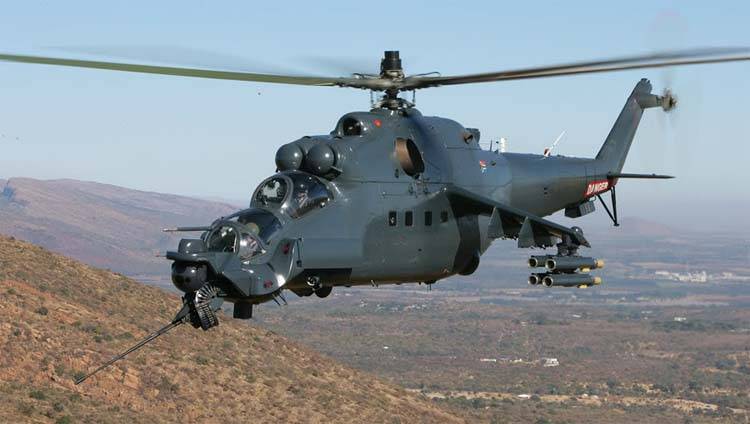
The main flight data of helicopters being upgraded in South Africa remained at the level of Mi-24В. But the main armament of the helicopter is completely redesigned. The main "anti-tank caliber" were eight Ingwe laser-guided anti-tank guided missiles with armor penetration around 1000 mm and a launch range of 5000 meters. In the near future, the Mokopane anti-tank systems with a launch range of 10 km are planned to be included in the Super Hind armament. Helicopters delivered to Azerbaijan are equipped with Ukrainian Barrier-V anti-tank systems with a launch range of up to 5000 m and armor penetration 800 mm behind dynamic protection. The Super Hind helicopter has the ability to use weapons of both Soviet production and NATO standards. A remote-controlled turret with a GI-20 2-mm automatic gun with high speeds and pointing angles horizontally and vertically is installed in the nose of the helicopter. With mass weaponscomparable to the 23-mm GSH-23L, the South African 20-mm double-feed gun fires 125 with projectiles at an initial speed of 1040 m / s and a rate of 750 fps / min. According to the manufacturer Denel Land Systems, 20-mm projectile with an armor-piercing core at a distance of 100 m can penetrate 50 mm armor.
Soviet combat "twenty-four" have a rich combat biography. But historically, more than in 90% of sorties, helicopters were involved not in fighting tanks, but in fire support for ground units, destruction of fortifications, strikes against positions and camps of various types of gangs and rebels. At the same time, the proportion of guided weapons used in airstrikes against unguided weapons of destruction was insignificant, and NAR, bombs, and built-in cannon weapons were used to destroy ground and surface targets. This is partly due to the high cost of modern guided missiles and the complexity of their use, but most often caused by the areal nature of the targets.
As a rule, the Mi-24 acted as a kind of flying armored MLRS, bringing down an uncontrollable rocket to the enemy in a few seconds. 128 57-mm NAR C-5, 80 80-mm NAR C-8 or 20 heavy 122-mm C-13 volley can not only sweep light field fortifications and destroy the enemy’s living force over a large area, but also has the strongest morale psychological effect. Those who are lucky enough to survive the air attack of "crocodiles" will never forget it.
In most cases, the use of large-caliber air bombs, bomb cassettes, incendiary tanks and submunitions equipped at KMGU was very effective. The small height of the discharge and the relatively low speed of the helicopter made it possible to place bombs with high accuracy. But the lack of free-fall bombs can be considered the need to fly over the target, which makes the helicopter vulnerable to anti-aircraft fire. In addition, when dropping bombs from a low altitude, there is a danger of a helicopter being hit by shrapnel, and therefore it is necessary to use slow-blow fuses.
Although the Mi-24 helicopters fought a lot, there are not many reliable combat episodes where they were used to fight armored vehicles. Within this publication, the experience of the combat use of the Mi-25 (export version of the Mi-24D) by Iraq and Syria is of the greatest interest.
During the Iran-Iraq war, Mi-25B had the opportunity to perform the entire possible range of tasks: fight tanks, destroy field fortifications and provide air support to the ground forces, destroy enemy enemy forces on the battlefield, escort troop helicopters, mine fields, conduct reconnaissance and adjustment of artillery fire, disperse chemical warfare agents and conduct air combat. Anti-tank "Phalanx", NAR S-5K / KO and KMGU-2 containers filled with mines and PTAB were used against Iranian armored vehicles. Most often, combat helicopters attacked Iranian М47, М60 and Chieftain Mk5 in places of concentration and on the march. In Iraq, the most trained crews of the Mi-25 used the tactics of “free hunting”. Information about the location of enemy tanks was transmitted by ground units or recorded by aviation reconnaissance. Also, the Iraqis were actively listening to the talks of the Persians in the VHF range. Based on the data obtained, combat missions carried out as part of a pair were planned. The facilitator searched for the enemy’s armored vehicles and launched an ATGM launch. Slave, in turn, covered the tank destroyer and suppressed the anti-aircraft artillery with the help of the NAR.
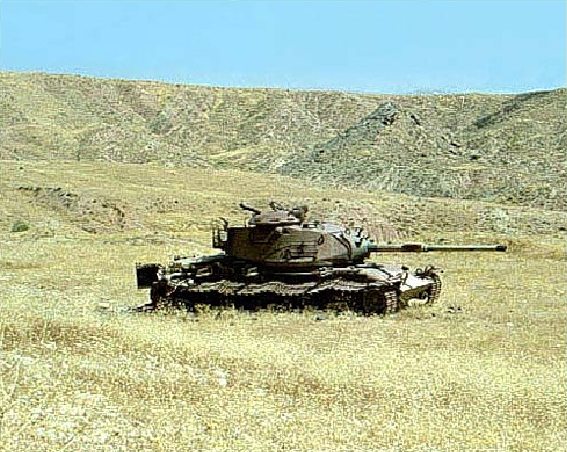
Iraqi helicopters sometimes successfully interacted with their own armored units. Mi-25, operating in conjunction with light anti-tank helicopters Aerospatiale SA-342 Gazelle, in July 1982, played a significant role in repelling the Iranian offensive near Basra. Parts of the 16, 88 and 92 armored divisions of Iran suffered heavy losses from the actions of air hunters. However, the anti-helicopter helicopters themselves had to operate in difficult conditions. Often, the desert character of the terrain with an overview of the horizon and the absence of elevations beyond which it was possible to secretly get close to the target made the sudden attack of helicopters difficult to implement. This, in turn, increased the vulnerability of combat helicopters. In addition, the Mi-25 were among the priority targets for Iranian fighters. In 1982, the Iranians managed to capture the Mi-25, which made an emergency landing. This car was exhibited in Tehran among other trophies.
During the Iran-Iraq war, Mi-25 first came together in air battles with other combat helicopters and enemy fighters. The data on the losses and victories of the parties are quite contradictory. Foreign researchers agree that the Iranian AH-1J Cobra destroyed 6 Mi-25 in air battles, losing their machines to 10. Over 8 years of armed conflict, 56 air combat took place with the participation of the Mi-25.
The crews of the Iranian Phantoms and Tomcats claim for several downed combat helicopters. However, the Mi-25 was not an easy target. So, on October 27 1982, the Iraqi Mi-24 in an air battle in the vicinity of the village of Ein Hosh destroyed the Iranian F-4 fighter. In a number of domestic sources, it is indicated that the Phantom was hit by the Phalanga-M ATGM, which of course is impossible. The maximum flight speed of an anti-tank missile 9М17М is 230 m / s, which is significantly less than the cruising speed of a jet fighter. And most importantly, the radio command guidance system "Rainbow-F" is physically unable to direct missiles at objects moving at a speed of more than 60 km / h. The effective means of fighting air targets that were in the Mi-25 arsenal are 57-mm unguided missiles and the four-barreled 12,7-mm machine gun YakB-12,7.
It is reliably known about the use of Syrian Mi-25 in the 1982 year against Israeli armored vehicles in Lebanon. The advancing Israeli units literally cluttered the narrow roads of Lebanon with armored vehicles. This and took advantage of the crews of the Syrian "crocodiles". According to Syrian data in 93 combat sorties, helicopter gunships, without losing any damage, destroyed more than 40 Israeli tanks and armored personnel carriers. However, these data are most likely overestimated. Even if the Syrians managed to achieve so many hits, this does not mean that all Israeli tanks were destroyed or hit. Modernized in Israel, the American M48 and M60, as well as the Merkava Mk.1 of their own design, were equipped with “reactive armor” Vlazer, which with a sufficiently high degree of reliability protected from cumulative ammunition.
At the beginning of the 80's, the Angolan Mi-25 attacked the columns of the South African army that invaded the country from Namibia. The priority targets included Olifant Mk.1A tanks (a modification of the British Centurion tank) and Ratel armored vehicles. Helicopter control Cuban crews. There is no reliable data on how many units of armored vehicles they managed to destroy, but a kind of reaction to the actions of military helicopters can be considered the active use of the enemy's trophy ZLU-23, MANPADS "Strela-2M", mobile short-range SAM systems "Strela-1".
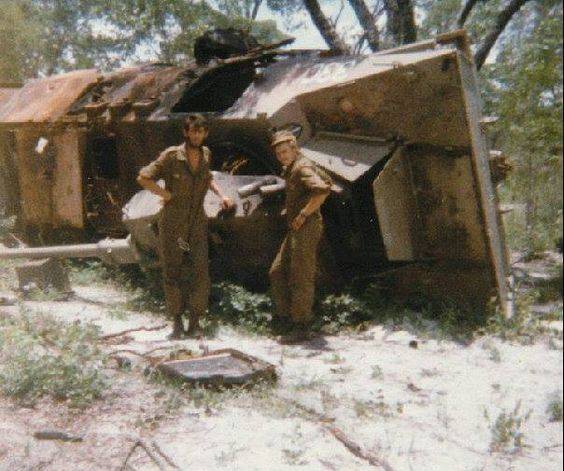
To reduce combat losses helicopter pilots had to operate at extremely low altitudes. During the fierce clashes by December 1985, all of the Angolan Mi-24 were lost or disabled.
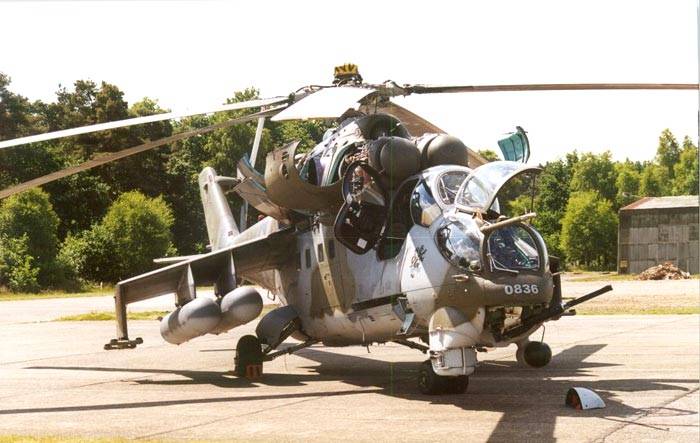
In 1986, three dozen Mi-35 and spare parts for the surviving helicopters were delivered from the USSR to Angola. With the help of Soviet specialists, several Mi-25s were brought back into operation. Combat helicopters Mi-25 and Mi-35 successfully operated against South African troops in the south-east of the country. However, the Cubans mostly fought on them, the Angolan pilots frankly avoided dangerous missions.
In addition to the fire support of their troops, strikes on UNITA camps, attacks by South African armored vehicles and transport convoys, in a number of cases helicopters solved transport problems of delivering food and ammunition to the front lines.
Combat "crocodiles" fought in another part of Africa. In 1988, the Mi-24 went to Ethiopia in addition to the existing Mi-35s. They were actively used in battles with Eritrean separatists. In the winter of 1989, two groups of Mi-35 attacked a convoy moving along a road in a mountain valley, which included armored personnel carriers. After the use of NAR C-8 and suspended gun containers UPK-23-250, several burning cars remained on the road. Mi-35 effectively hunted for high-speed armed Eritrean boats. Mi-35 was successfully used not only against ground, but also surface targets. Combat helicopters managed to destroy about a dozen armed speedboats of separatists in the Red Sea, attacking transports waiting for their turn for unloading or following to Ethiopian ports.
In 1998, in addition to the existing combat helicopters, Ethiopia received a batch of overhauled and modernized Mi-24В from Russia. During the Ethiopian-Eritrean conflict, which lasted from 1998 to 2000, the Ethiopian “crocodiles” destroyed at least 15 Eritrean T-54 / 55 tanks. At least one helicopter was shot down by forces of the army air defense and several more were damaged. In February 1999, one damaged Mi-35 made an emergency landing behind the front line and was captured. Subsequently, with the participation of Ukrainian specialists, the helicopter was restored, and it was incorporated into the Eritrea Air Force.
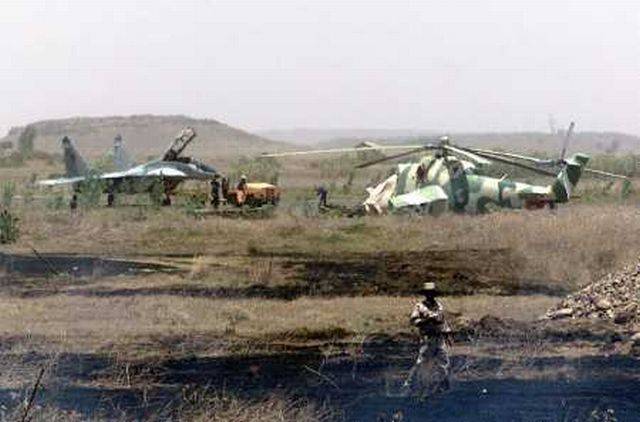
After the end of hostilities, another Mi-24B was hijacked to Eritrea. Both helicopters are currently at Asmara airbase. Their operation continued until the beginning of the 2016 year. Now helicopters due to poor technical condition in the air do not rise.
Approximately 30 of the Libyan Mi-24A and Mi-25 participated in the civil war in Chad. "Crocodiles" were used mainly against manpower and all-wheel drive pickups, which were mounted recoilless guns, large-caliber machine guns and anti-aircraft installations. The success of the Libyan helicopter gunships is unknown, but the 7 Mi-24A and Mi-25 were lost. A couple of “twenty-fours” were shot down by air defense weapons at the disposal of the Chadian dictator Hiessen Habré, two more helicopters were destroyed by saboteurs at the Maaten S-Saray airbase, and three in good condition in March 1987 were captured at Wadi Dum airbase. The captured helicopters were subsequently transferred to the United States and France as a token of gratitude for military assistance in the fight against the forces of Muammar Gaddafi. And this assistance was very significant: airborne units and two squadrons of Jaguar fighter-bombers took part in the fighting from France, and massive supplies of modern weapons from the USA, including such complex systems as the Tou and the air defense missile systems "Hawk".
In the 90-2000-s on the African continent, "twenty-four" various modifications fought in Zaire, Sierra Leone, Guinea, Sudan and Cote d'Ivoire. They were piloted by their mercenaries from the countries of the former Warsaw Pact, the CIS and South Africa. Often one appearance in the sky of "crocodiles" was enough for the soldiers of the opposing side to disperse in horror. As during other local conflicts, the Mi-24 in central Africa was mainly used by the NAR for land targets. The losses of the twenty-fours were insignificant in this case, the helicopters mostly fought because of mistakes in management and because of poor maintenance. In November 2004, five Mi-24s were destroyed by French troops on the ground in response to an air strike against the base of the French Foreign Legion.
The Mi-24 of the Ivorian air force that participated in the internal conflict were acquired in Belarus and Bulgaria. The nationality of the pilots who made combat missions on them has not been disclosed. On the part of the helicopters, mobile four-barreled large-caliber machine guns were dismantled. Instead, for actions against manpower and poorly protected equipment, containers with 23-mm guns were hung up. It is reported that at the beginning of 2017, the new twenty-two party arrived at the air base in Abidjan.
Soviet Mi-24 were first used in combat in Afghanistan. But the armored vehicles of the Mujahideen were not, the helicopters provided fire support to the ground forces, hunted for caravans with weapons, and struck the bases and fortifications of the rebels. Mi-24В and Mi-24П actively fought during the two Chechen campaigns. The first reliably known case of using “twenty-fours” against separatist armored vehicles was recorded on November 23 of the year 1994. During the joint strike of the Su-25 attack aircraft and Mi-24 helicopters at the location of the tank regiment in Shali, the 21 tank and the 14 BTR were destroyed.
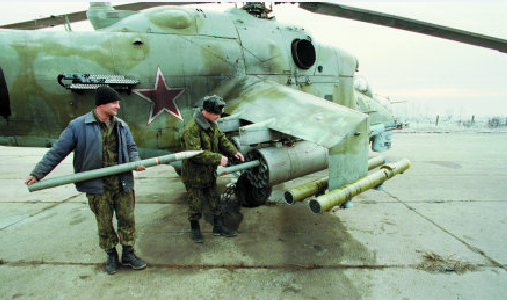
In the initial period of the “constitutional order” operation, when the enemy still had a significant number of armored vehicles, the crews of combat helicopters quite often used Sturm-V missiles. The 40 C-8 unguided missiles were fired for approximately one ATGM. In some cases, the Mi-24 were attracted to repelling the attacks of enemy tanks. 22 March 1995 of the year in repulsing the attack of militants from Shali and Gudermes who, with the support of armored vehicles, attempted to unlock Argun, the Mi-24В link destroyed the 4 tank and before the 170 militants. After that, the Chechens began to avoid frontal attacks using tanks and infantry fighting vehicles, using them as roaming firing points. For their identification, air defenders and aircraft navigators were involved, in the role of which Mi-8MT helicopters were usually used. 26 March 1995 of the year Mi-8MT brought a group of 6 Mi-24 to a large squad of Dudaevs, traveling by car and armored vehicles. As a result, 2 armored vehicles, 17 vehicles and more 100 thugs were destroyed. In addition to armored vehicles and vehicles, ATGMs were intensively used for the point of destruction of firing points, command posts and ammunition depots. Soon this led to the fact that the helicopter regiments involved in the fighting, there was a shortage of guided missiles. According to official data published in 1994-1995, the actions of army aviation in Chechnya destroyed 16 tanks, 28 infantry fighting vehicles and armored personnel carriers, 41 MLRS Grad, 53 guns and mortars and many other equipment.
During the first campaign, the main defenses of the Chechen militants were machine guns of caliber 12,7-14,5 mm and MZA caliber 23-37-mm. There were also 85-100 anti-aircraft guns used in anti-avalanche service during the Soviet era. But the combat value of large-caliber anti-aircraft guns when firing at air targets without an IMT is questionable. In addition to specialized anti-aircraft weapons, fire on helicopters was conducted from light small arms and anti-tank grenade launchers.
The irretrievable losses of the Mi-24 in First Chechen made 4 machines. Several “twenty-fours”, having received serious combat damage, managed to return to the airfields or make an emergency landing in the disposition of their troops. This was facilitated by a good security helicopter. Steel armor with a thickness of 4-5-mm covered the cockpit, gearbox, engine oil tanks, gearbox and hydraulic tank, which made it possible to hold two thirds of the bullets. The bulletproof glass showed sufficiently high resistance, although the greatest number of hits on the Mi-24 occurred exactly in the front, during the attack, and the navigator-operator was the one who was most affected.
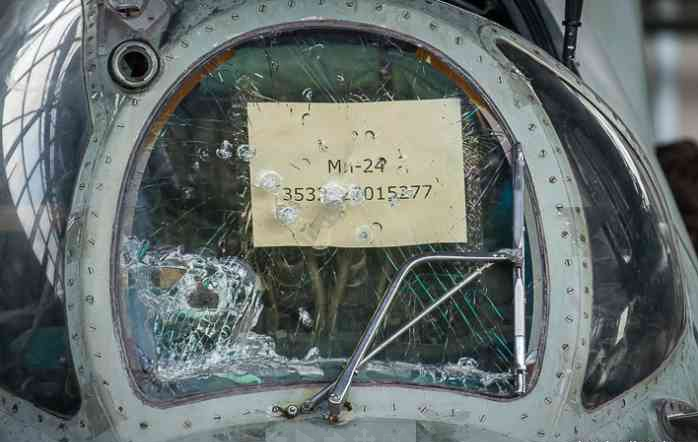
Engines are very vulnerable to combat damage, but in the event of a single engine failing, the second automatically went into emergency mode. Even with a shot-down gearbox and a full “oil starvation,” it was possible to hold 15-20 minutes in the air. Most often, the helicopters suffered from lumbago hydraulic systems, power supply and control, stretched across the entire helicopter, although duplication in many cases allowed to save the car. As in Afghanistan, the insecurity of the Mi-24 from the rear was confirmed, the helicopter had a vulnerable dead zone at the exit from the attack.
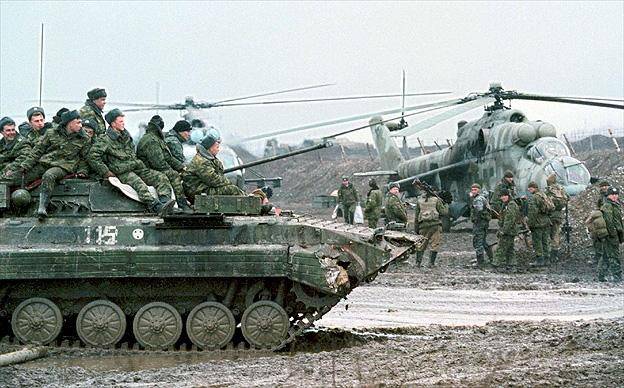
During the second campaign, the helicopters were used with no less intensity. But the combat losses of the Mi-24 during the “counterterrorist operation” from 9 August 1999 to 19 June 2000, increased significantly and amounted to 9 Mi-24. This was due to the fact that the enemy made the appropriate conclusions and prepared, paying great attention to the improvement of air defense. If in 1994-1995, launches of MANPADS could be counted on fingers, then in four years the militants managed to accumulate a fair amount of these weapons. The use of guided anti-tank missiles in the second campaign was much more rare. That was explained both by the deficit of the ATGM and by the small number of targets for them.
It is rather difficult to evaluate the effectiveness of the Mi-24 as a tank destroyer. This undoubtedly outstanding vehicle was successfully involved in many conflicts, but mainly in the role of assault, rather than anti-tank helicopters. It should be recognized that the idea of "flying BMP" was untenable. As a paratrooper, the Mi-24 was significantly inferior to the Mi-8 helicopter. The “Twenty-fours” paratroopers drove extremely rarely and, mostly, carried around 1000 a kilogram of useless load in the form of an amphibious compartment. If the Mi-24 altitude and rate of climb were generally sufficient for warfare in Europe, the warfare in hot climates and high mountains raised the question of raising the static ceiling. This could be achieved quickly only by increasing engine power. In the second half of the 80-x on the engines TV3-117 installed new electronic speed control. For a short-term increase in engine power during takeoff and landing, a water injection system was introduced in front of the turbine. As a result, the static ceiling of the Mi-24D and Mi-24В helicopters was managed to be brought to the 2100 m. But for a cardinal increase in the combat characteristics of this it turned out to be little.
Armored Mi-24, designed to achieve high speed due to the presence of "dead weight" in the form of amphibious compartment, was frankly overweight. This circumstance is aggravated by the fact that the helicopter was installed from the very beginning with a “high-speed” main rotor with a low efficiency in the hover mode. As a result, it is very difficult to use ATGMs in a hangup mode, maneuver at low speeds and implement such an effective anti-armor technique as a short-term vertical jump due to natural heights, with a hang in place and simultaneous launch of guided anti-tank missiles. Moreover, at full combat load, pilots prefer to take off on an “aircraft”, with a run-up runway 100-120 meters. Thus, when operating from small field unpaved airfields, restrictions are imposed on the take-off weight of combat helicopters, which naturally affects the impact capabilities.
The shortcomings of the Mi-24 became clear after the start of operation in the front-line units, and the concept of using a combat helicopter was revised. When designing advanced combat helicopters, the designers took into account the experience of creating and using the Mi-24. On new cars there was a rejection of the useless landing cockpit, due to which it was possible to reduce the size, reduce weight and increase thrust-to-weight ratio.
During Soviet times, about 2300 Mi-24 helicopters of various modifications were transferred to the helicopter regiments. At the time of the collapse of the Soviet Union, there was a little more than 1400 Mi-24 in the ranks. Some of these cars went to the "fraternal republics" of the former USSR. The legacy of the Soviet army was used in armed conflicts that broke out in the post-Soviet space, and was actively sold at dumping prices on the international arms market. On the one hand, this led to the fact that the Mi-24 gained the widest distribution, becoming the most belligerent fighting helicopter in the world, on the other hand, the number of capable twenty-fours in the CIS countries dropped sharply. This fully applies to our army aviation. Over the years of the “reforms”, due to the lack of timely repairs and proper maintenance at the Russian military airfields and storage bases, a lot of “twenty-fours” have rotted. Currently, according to data published by World Air Forces 2017 and Military Balance 2017, there are 540 combat helicopters in the Russian armed forces. Of these, about 290 - Mi-24В, Mi-24П, Mi-24ВП Soviet-built. Relatively recently, army aviation added six dozens of Mi-24BH and Mi-24ВМ (Mi-35М).
However, information regarding the number of our combat helicopters, given in Western sources, should be treated with caution. As is known, it is very common for our probable partners to overstate the numerical strength of the Russian military equipment available to the troops, thus justifying the growth of their own military spending. In addition, the main part of the “twenty-fours” built in the USSR, in view of the development of the resource, is at the end of its life cycle or needs major repairs and modernization.
Продолжение следует ...
Based on:
http://www.zid.ru/products/defence/44/detail/175
http://kkorablevv.narod.ru/index/0-12
http://bmpd.livejournal.com/1284533.html
http://army-news.ru/2010/10/vertolet-mi-24/
http://www.denellandsystems.co.za/products/weapons
http://www.airwar.ru/history/locwar/africa/eritrea/eritrea.html
http://www.ordtech-industries.com/2products/Ammunition/Medium/20x139.html
http://mi-24.com/2015/08/09/mil-mi-24-hind-maintenance-during-soviet-afghanistan-war/
http://www.madote.com/2010/02/pictures-of-eritrean-air-force.html
AB Shirokorad. History aviation weapons.
The Military Balance 2016
World Air Forces 2017
- Linnik Sergey
- Aviation against tanks (part of 1)
Aviation against tanks (part of 2)
Aviation against tanks (part of 3)
Aviation against tanks (part of 4)
Aviation against tanks (part of 5)
Aviation against tanks (part of 6)
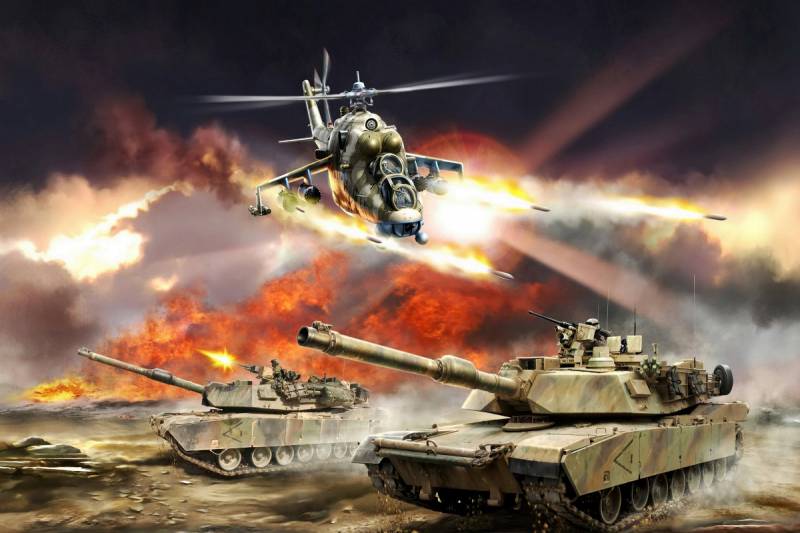
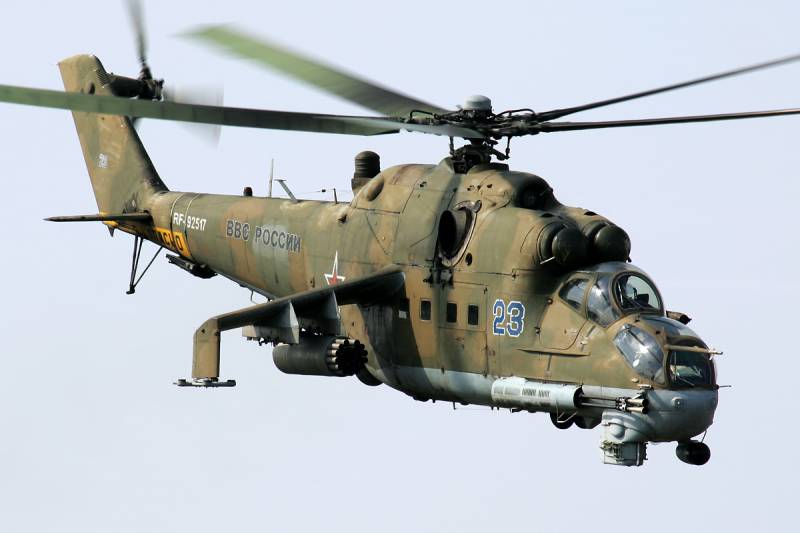
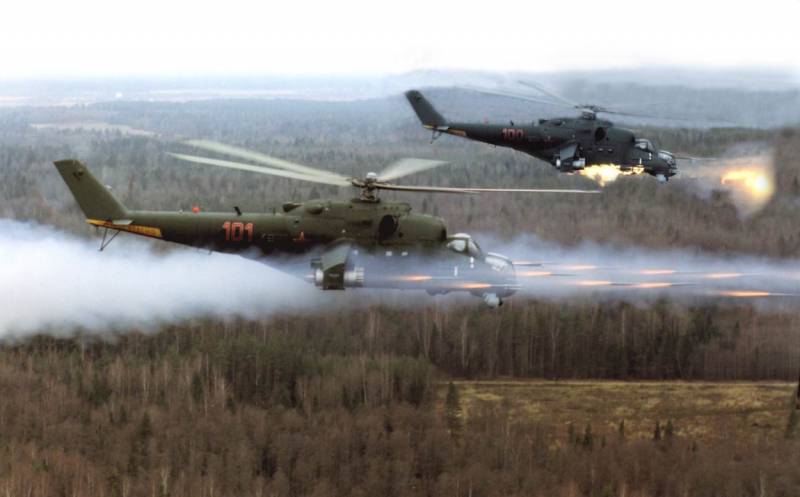
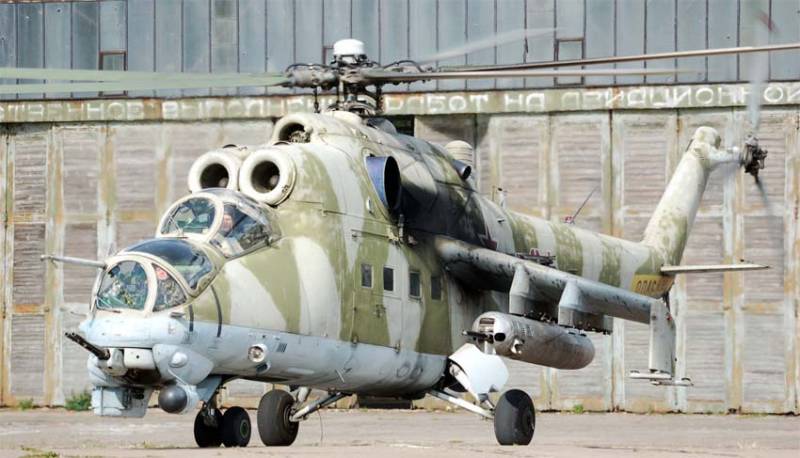
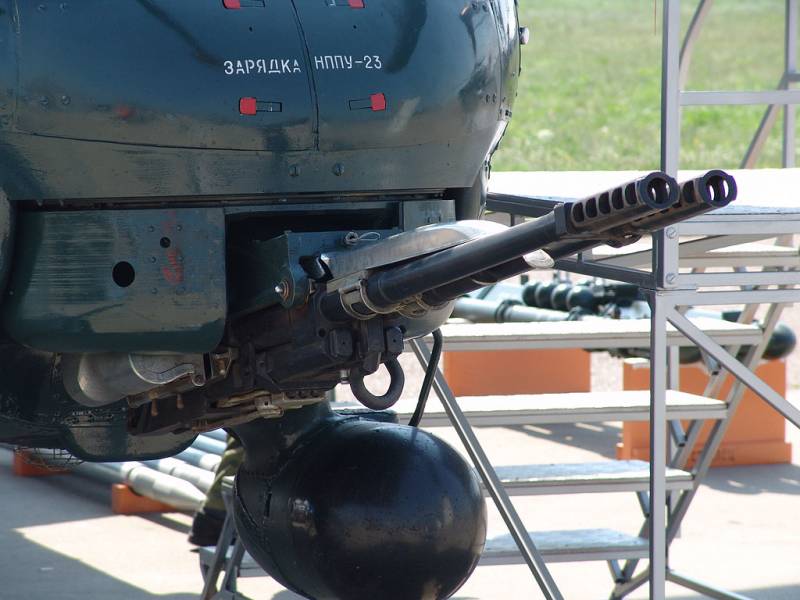
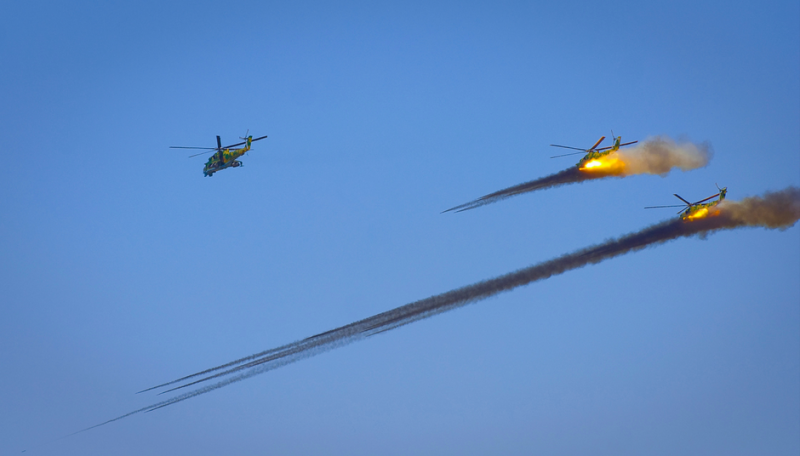
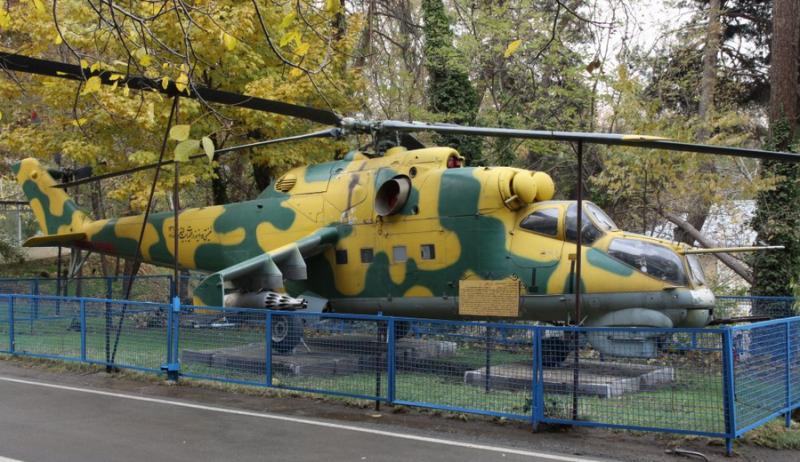
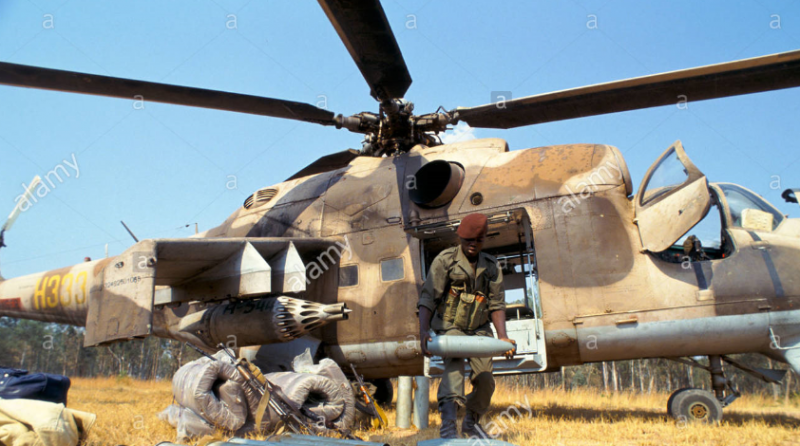
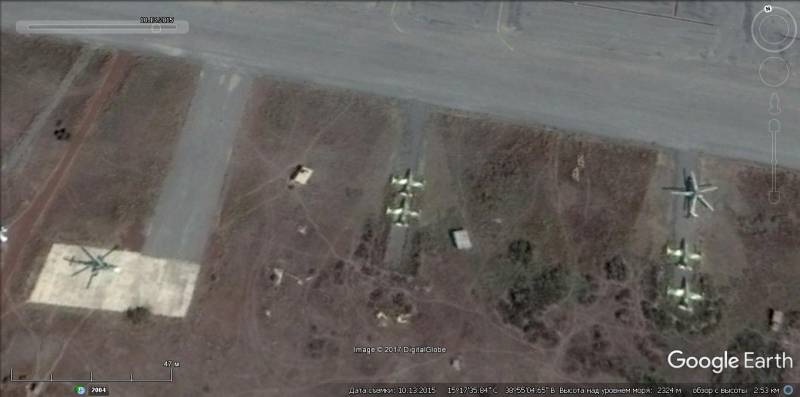
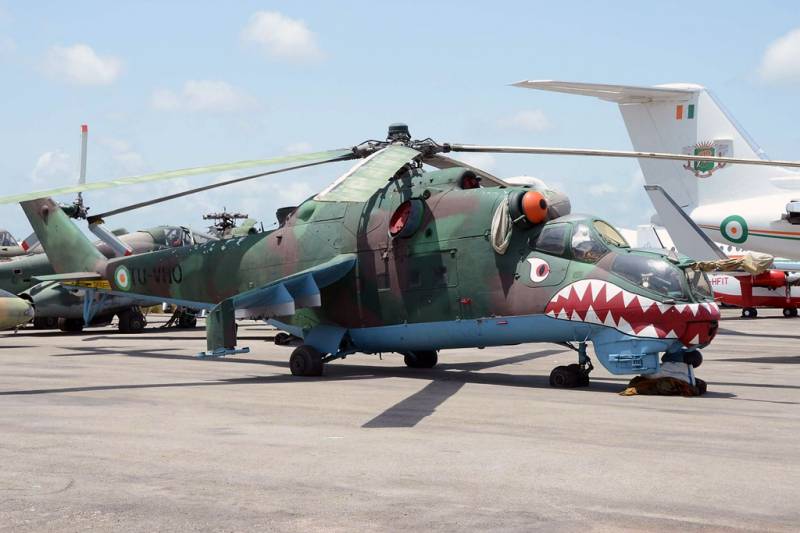
Information